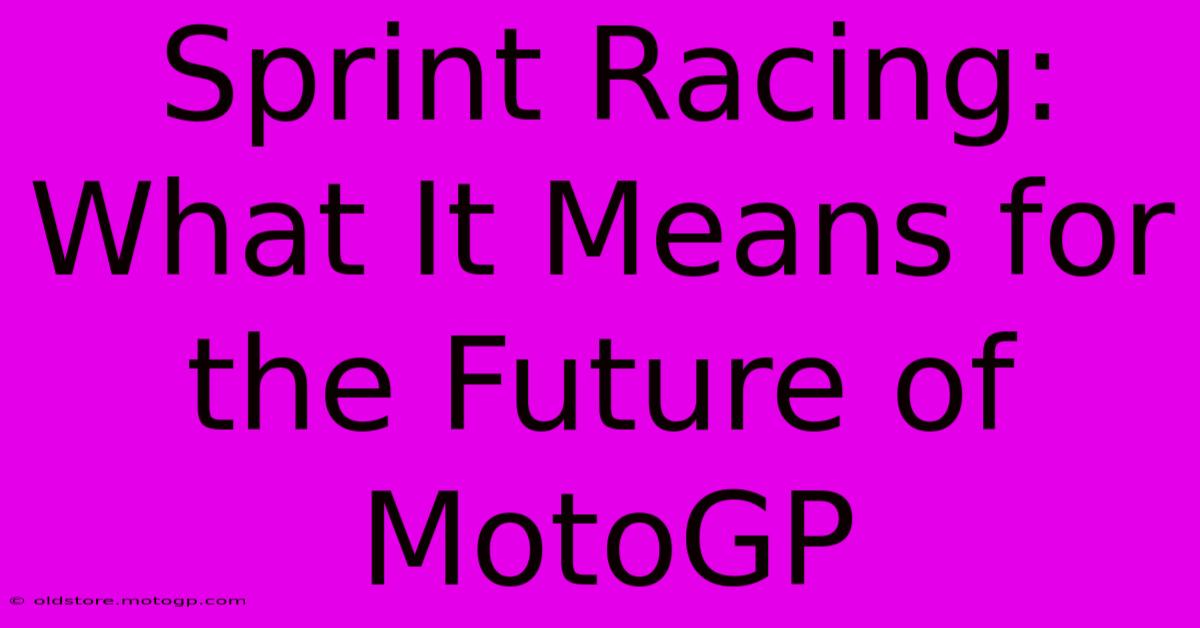Sprint Racing: What It Means For The Future Of MotoGP

Table of Contents
Sprint Racing: What It Means for the Future of MotoGP
MotoGP, the pinnacle of motorcycle racing, is constantly evolving. In 2023, a significant change shook the sport: the introduction of sprint races. This addition, a shorter race held on Saturday, has sparked considerable debate among fans, riders, and teams. But what does this mean for the future of MotoGP? Let's delve into the implications of sprint racing and explore its potential long-term effects.
The Impact of Sprint Races on MotoGP
The introduction of sprint races has undeniably altered the MotoGP weekend format. Previously, the focus was solely on the main Sunday race, with Saturday dedicated to qualifying and practice sessions. Now, Saturday features a high-stakes sprint race, awarding valuable championship points. This change has several key implications:
Increased Competition and Excitement
One immediate benefit is the heightened level of competition. With points on the line in both the sprint race and the main race, riders are pushing harder from the very start of the weekend. This increased intensity translates into more exciting races, with overtaking maneuvers and strategic gameplay playing a larger role. The pressure is on throughout the entire weekend, creating a more compelling spectacle for viewers.
Shifting Race Strategies and Team Dynamics
The sprint race has forced teams to rethink their race strategies. Prioritizing tire management and fuel conservation becomes even more crucial, as riders now have to manage their resources across two races in a single weekend. This adds a layer of complexity and demands greater tactical flexibility from teams and riders alike. The addition of the sprint race demands more precise calculations and planning, showcasing the evolving strategic depth of MotoGP.
Financial Implications and Increased Viewership
The extra race generates more revenue opportunities for Dorna Sports, the commercial rights holder of MotoGP. This increased revenue could potentially be reinvested in the sport, improving infrastructure and attracting new sponsors. More importantly, sprint races have been argued to attract a wider audience, introducing the sport to new viewers who might not have followed the sport as closely before. The increased visibility could lead to a boost in sponsorship, fan engagement and overall popularity of the sport.
Potential Drawbacks and Criticisms
Despite its positives, the sprint race format isn't without its detractors. Some critics argue that the added race puts excessive strain on riders and teams, potentially leading to increased risk of injury and burnout. The shorter race length also means less time for strategic maneuvering and overtaking opportunities. Some have argued that the sprint races diminish the importance of the main race itself, creating a sense of anticlimax.
The Future of Sprint Racing in MotoGP
The long-term impact of sprint races on MotoGP remains to be seen. However, Dorna Sports seems committed to the format, regularly assessing its success and making adjustments as needed. The future may see modifications to the points structure, race length, or even the inclusion of sprint races across different classes.
Factors to consider for the future include:
- Rider feedback: Continuous evaluation of rider opinions and suggestions is crucial for the long-term success of sprint races.
- Fan engagement: Dorna will continue to monitor fan reaction and engagement levels to determine the impact on viewership and popularity.
- Technological advancements: Future technological developments in bikes and safety equipment could influence the feasibility and safety of sprint races.
The introduction of sprint races represents a bold gamble for MotoGP. Whether it proves to be a successful and sustainable addition remains to be seen. However, it's clear that sprint racing has already significantly impacted the sport's dynamics, adding a new layer of excitement and competition while presenting new strategic and logistical challenges. Only time will tell if this shift strengthens the sport or creates lasting negative consequences. The future of MotoGP, in some ways, hinges on the ongoing success and adaptation of the sprint race format.

Thank you for visiting our website wich cover about Sprint Racing: What It Means For The Future Of MotoGP. We hope the information provided has been useful to you. Feel free to contact us if you have any questions or need further assistance. See you next time and dont miss to bookmark.
Featured Posts
-
Cota Parking A Comprehensive Guide To Parking At Cota
Feb 23, 2025
-
Discover The Charm Of The Queen Circuit
Feb 23, 2025
-
Moto2 Specs The Key To Unlocking Speed
Feb 23, 2025
-
The Future Of Us Grand Prix Sprint Time
Feb 23, 2025
-
Austin Gp Sprint Race The Sound Of Speed
Feb 23, 2025
